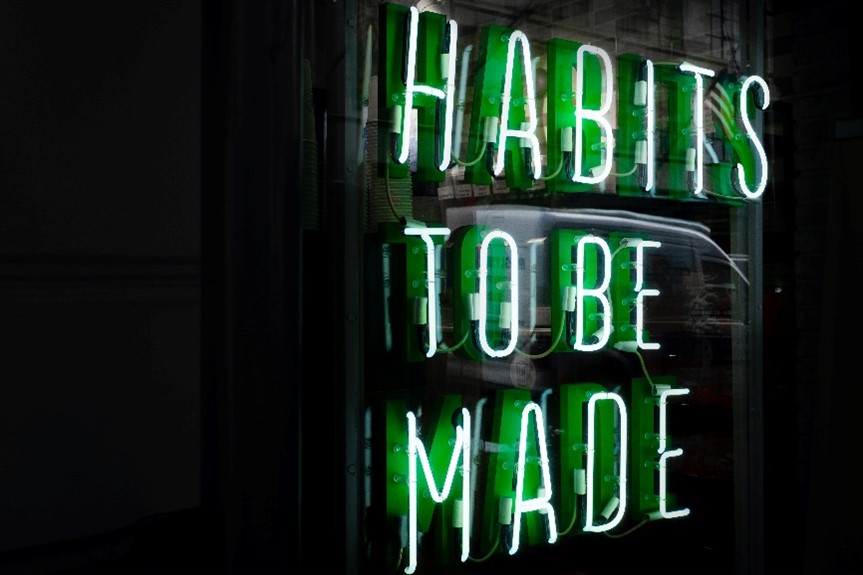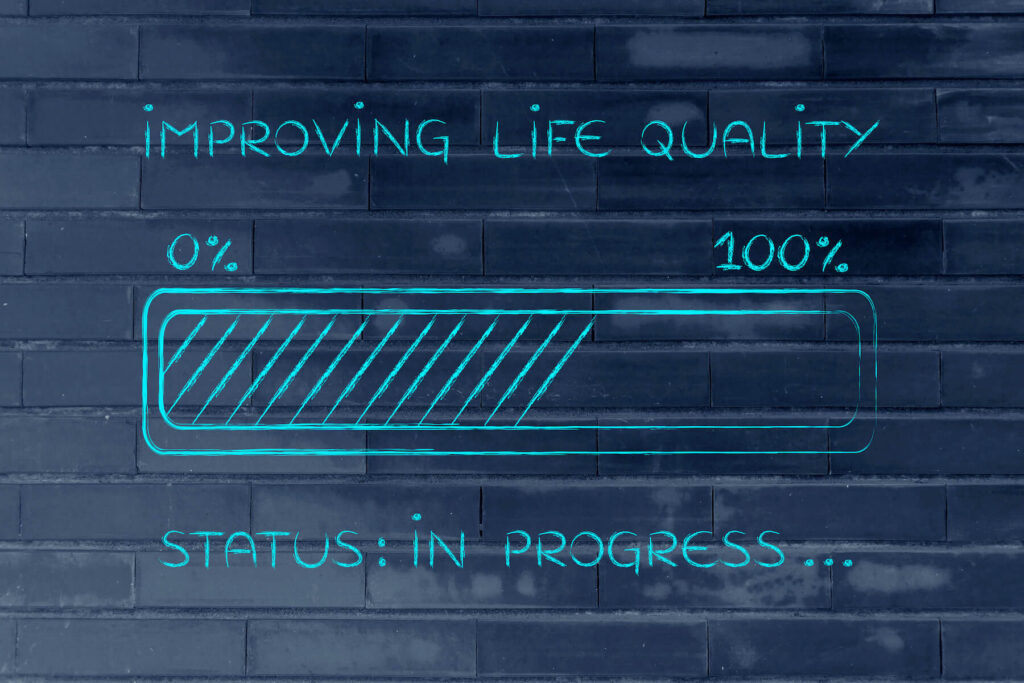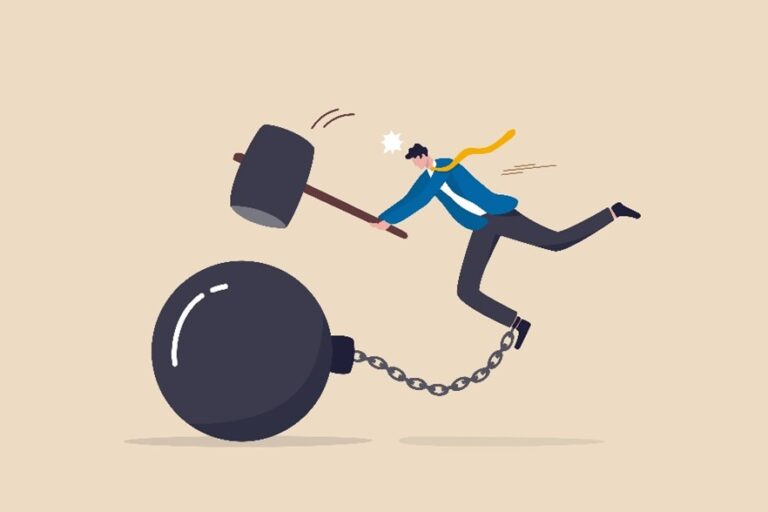We go through life assuming we’re in the driver’s seat but often there are other important influences driving our actions. One of them is habits–the things we do often and regularly, sometimes without knowing that we’re doing them.
The function of habit learning occurs in the basal ganglia, a group of subcortical nuclei in our brains. A Duke University researcher estimated that more than 40 percent of the actions we take each day are based on habits, not decisions.
Our brains consume a tremendous amount of energy, so we’re wired to preserve that energy whenever possible. If we can avoid engaging our cognitive processing power in certain situations, such as making decisions or invoking our willpower, we’ll naturally take the less energy-intensive path by default.
That works well in term of cognitive energy efficiency but not so well in our profile of habits. Unfortunately, many of our habits are counterproductive, detracting from our quality of life.
Bad Habits to Avoid
We all have bad habits. The question is: how many–and what will we do about them?
Below is a list of 36 of the most common bad habits. (As you review it, make a note of the ones that you’ve engaged in.)
- Advice: giving advice without being asked
- Avoiding hard or uncomfortable things, topics, or people
- Being alone too much
- Being inside too much and not getting fresh air and sunshine
- Being late
- Being passive instead of taking action
- Binge-watching shows or content
- Blaming others instead of taking responsibility and finding solutions
- Catastrophizing
- Complaining
- Compulsively using social media and smartphones (often a form of numbing)
- Doubting ourselves
- Drinking habits, such as not drinking enough water or drinking too much alcohol
- Exercise: not moving enough
- Feeling sorry for ourselves
- Financial: overspending and not saving and investing
- Food: overeating, eating too quickly, stress- or binge-eating, eating junk food or fast food too much, or eating late at night (detracting from sleep quality)
- Getting caught up in urgent but unimportant tasks
- Having a victim mindset
- Losing touch with family and friends due to being too “busy”
- Lying
- Making excuses
- Negative self-talk
- Not removing ourselves from toxic people, relationships, or bosses
- Overcommitting on things (and not learning to say “no”)
- Overpromising and underdelivering on tasks
- Playing the short game (doing what’s easy or right in front of us instead of looking ahead and investing for our future)
- Procrastinating
- Quitting
- Reacting to situations instead of anticipating and driving them
- Sitting too much
- Sleep: irregular sleep times, scrolling on the phone or watching TV before bed, consuming caffeine late in the day, and other actions that reduce our sleep quality
- Smoking
- Taking the easy way out
- Talking about people behind their back
- Work habits, such as overwork, work addiction, checking email compulsively (and first thing in the morning or each time we open our computer or smartphone), not taking vacations, or staying too long in bad jobs
Clearly, there are many bad habits. The more we have, the more we’re shooting ourselves in the foot when it comes to the quality of our life and work. Sometimes we let our bad habits go on for years or even decades.
It’s important to understand that our bad habits often signal something deeper–a problem or concern that prompts us to engage in a bad habit as a coping mechanism. Though there are many causes of bad habits, researchers point to two underlying culprits: stress and boredom. (Stress, of course, has many underlying causes.)

Take the Traps Test
We all fall into traps in life. Sometimes we’re not even aware of it, and we can’t get out of traps we don’t know we’re in. Evaluate yourself with our Traps Test.
How to Break Bad Habits and Create Good Ones

Unfortunately, our bad habits can add up to big problems over time: poor health, lower performance, unhappiness, feeling stuck, lost time, and harm to our relationships. So what to do about them?
It’s not as simple as trying to increase our willpower so we can be stronger when it comes to avoiding bad habits. We need more sustainable strategies, since our willpower can erode over time. And we must begin by believing that we can change our habits.
There are many approaches we can take:
Study our bad habits.
Develop self-awareness and get a clear sense of the patterns of our bad habits: What triggers them? How and when? Where? With whom? How often? Then devise a plan to derail those factors driving bad habits.
Understand the underlying drivers of our bad habits and deal with those deeper issues.
If stress is prompting one or more bad habits, deal directly with the person or issue that’s causing the stress. That will eliminate the need for a habitual coping mechanism.
Focus on “keystone habits,” since they have leverage over several areas of our life.
In his excellent book, The Power of Habit, Charles Duhigg noted the importance of “keystone habits” that can cause widespread shifts in other areas. For example, he cites the following research about leading keystone habits:
- A habit of regular exercise often leads people to eat better, smoke less, become more productive at work, show more patience with people, use credit cards less, and report feeling less stressed. (“Exercise spills over. There’s something about it that makes other good habits easier.” -James Prochaska, University of Rhode Island researcher) Exercise has been a powerful keystone habit for me and many of the people I know who thrive in their chosen personal and professional contexts.
- The habit of eating together as a family is associated with children having more confidence and emotional control, as well as better homework skills and grades.
- The habit of making our beds each morning is associated with higher productivity, greater financial discipline, and a greater sense of well-being.
Prime our environment to promote good habits and prevent bad ones.
For example, we can set out our workout clothes and gear the night before so we’re more likely to exercise in the morning. Or we can prepare healthy meals on weekends and pre-pack them in containers so they’re ready for the week ahead. We can leave our smartphones in a different room when we need to focus so we’re not tempted by their notifications or buzzing. (Source: James Clear, Atomic Habits)
“Environment is the invisible hand that shapes human behavior. We tend to believe our habits are a product of our motivation, talent, and effort. Certainly, these qualities matter. But the surprising thing is, especially over a long time period, your personal characteristics tend to get overpowered by your environment…. We will naturally gravitate toward the option that requires the least amount of work…. Create an environment where doing the right thing is as easy as possible.”
-James Clear, writer and speaker
Focus on developing systems that promote good habits instead of simply setting goals and trying to reach them.
Can we automate things that we do over and over? Set up processes that help us eliminate non-essential tasks and avoid repetition? Use our calendar to ensure we’re focusing on the right things at the right time? Collaborate well with others so that we can all operate at our best?
“If you want better results, then forget about setting goals. Focus on your system instead….
You do not rise to the level of your goals. You fall to the level of your systems.”
-James Clear
Follow the four laws of behavior change when creating better habits:
- Make it obvious. Example: use a visual cue that tees up the intended behavior. When I leave out the materials I need for my workout drink, it reminds me to get my workout in.
- Make it attractive. Example: give yourself a reward—ideally something you crave—after you do the desired habit, such as getting to watch your favorite show that night only if you reach your daily quota on completing that important project.
- Make it easy. Example: if your phone is in another room while you’re doing deep work, it won’t be difficult to fight the temptation to check emails.
- Make it satisfying. Example: use a checklist and revel in noting your progress as you go when you’ve had the discipline to do your important work for the day. (Source: James Clear, Atomic Habits)
Focus on who we wish to become through our good habits and systems, not on what we want to achieve.
There’s something surprisingly powerful about this one. If we become the kind of person who exercises every day, or who eats healthy food, it starts to become engrained and automatic. We don’t have to keep fighting for it. We live into it.
“The most effective way to change your habits is to focus not on what you want to achieve, but on who you wish to become…. Your identity emerges out of your habits. Every action is a vote for the type of person you wish to become.”
-James Clear
Focus on replacing bad habits with good habits instead of on breaking our bad habits.
For me, replacing a hazy morning of checking the news or email with an intentional morning of reading, affirmations, meditation, prayer, and exercise has been a game changer. Another example: if tempted to smoke, do a deep-breathing exercise instead. A simple replacement can go a long way.

Personal Values Exercise
Complete this exercise to identify your personal values. It will help you develop self-awareness, including clarity about what’s most important to you in life and work, and serve as a safe harbor for you to return to when things are tough.
Eliminate the triggers that our brains associate with the bad habit.
Don’t keep junk snacks in the pantry. Turn off the notifications. Move the remote control away from the TV.
Leverage technology to help us automate our habits.
Build good habits into our calendar and set reminders for them. Many apps have this functionality built in, but keep in mind that apps use neuroscience in the war for our attention. This one can be a double-edged sword, so be wary.
Find an accountability partner to help with habits.
Make joint commitments, check in regularly to hold each other accountable, and celebrate progress and victories together.
Surround ourselves with people who live the way we want.
We’re social beings, so we don’t want to be viewed as the one who lets others down or doesn’t follow through with commitments. Also, we can surround ourselves with visual cues of what we want—like photos, posters, paintings, screen savers, Post-It notes, whiteboard messages, refrigerator decorations, or vision boards with a message or images of our desired future.
Try not to break the streak of a good habit.
Track progress and celebrate success as we go along so that we feel a sense of progress and momentum. Sometimes gamification or challenges can be real motivators for us (motivation to succeed and/or motivation to avoid failure).
Anticipate setbacks.
Don’t expect perfection in all habit-busting domains. We’re all imperfect and we all encounter new contexts, some of which make it harder to follow through and maintain progress. If or when there is a letdown, commit to getting back on track right away so the bad habit groove doesn’t re-establish itself.
Final Thoughts
There you have it: fourteen approaches for breaking bad habits and developing good habits in their place.
Sometimes we assume that we have to make things difficult. We must fight for the things we want, we have to go after our goals, we have to invoke our willpower over and over again. That’s all right, at least sometimes, but it’s not nearly enough.
What if we could replace our bad habits with good ones, design our environment to be more conducive to the life we want to live, and develop systems that help us be our best? That would mean great leverage—much more progress, even with less fighting and effort. We could stop shooting ourselves in the foot and instead help elevate our days, habit by habit.
“The secret to getting results that last is to never stop making improvements…. Small habits don’t add up. They compound. That’s the power of atomic habits. Tiny changes. Remarkable results.”
-James Clear
Reflection Questions
- What are your most detrimental bad habits?
- How are they affecting your quality of life?
- What will do about them, starting now?
Tools for You
- Traps Test (Common Traps of Living) to help you identify what’s getting in the way of your happiness and quality of life
- Personal Values Exercise to help you clarify what’s most important to you
- Quality of Life Assessment to help you discover your strongest areas and the areas that need work and then act accordingly

Quality of Life Assessment
Evaluate your quality of life in ten key areas by taking our assessment. Discover your strongest areas, and the areas that need work, then act accordingly.
Related Traps
- Avoiding
- Blaming
- Catastrophizing
- Comparing
- Complacency
- Negative Self-Talk
- Numbing
- Workaholism
- Overthinking
- Postponing Happiness
- Lacking Self-Awareness
Postscript: Inspirations on Habits
- “All our life, so far as it has definite form, is but a mass of habits.” -William James, 1892
- “Drop by drop is the water pot filled.” -Siddhartha Gautama (the Buddha)
- “Habit, if not resisted, soon becomes necessity.” -Saint Augustine, theologian and philosopher
- “First forget inspiration. Habit is more dependable. Habit will sustain you whether you’re inspired or not.” -Octavia Butler, science fiction writer
- “If you are going to achieve excellence in big things, you develop the habit in little matters.” -Colin Powell, U.S. Army officer, statesman, and diplomat
- “Habits are the compound interest of self-improvement.” -James Clear, writer
- “Success is the product of daily habits—not once-in-a-lifetime transformations.” -James Clear
- “Self-control is a short-term strategy, not a long-term one.” -James Clear
- “Good habits are worth being fanatical about.” -John Irving, novelist
- “Good habits formed at youth make all the difference.” -Aristotle, ancient Greek philosopher
- “Habits change into character.” -Ovid, ancient Roman poet
- “In essence, if we want to direct our lives, we must take control of our consistent actions. It’s not what we do once in a while that shapes our lives, but what we do consistently.” -Tony Robbins, author, entrepreneur, and philanthropist
- “Motivation is what gets you started. Habit is what keeps you going.” -Jim Rohn, entrepreneur and author
- “Successful people are simply those with successful habits.” -Brian Tracy, Canadian-American author and speaker

Gregg Vanourek’s Newsletter
Join our rapidly growing community. Sign up now and get monthly inspirations (new articles, opportunities, and resources). Welcome!
++++++++++++++++++++++++++++++
Gregg Vanourek is a writer, teacher, & TEDx speaker on personal development and leadership. He is co-author of three books, including LIFE Entrepreneurs: Ordinary People Creating Extraordinary Lives (a manifesto for living with purpose and passion) and Triple Crown Leadership: Building Excellent, Ethical, and Enduring Organizations (a winner of the International Book Awards). Take Gregg’s Traps Test (Common Traps of Living), complete his Personal Values Exercise, check out his Best Articles, or get his newsletter. If you found value in this article, please forward it to a friend. Every little bit helps!

